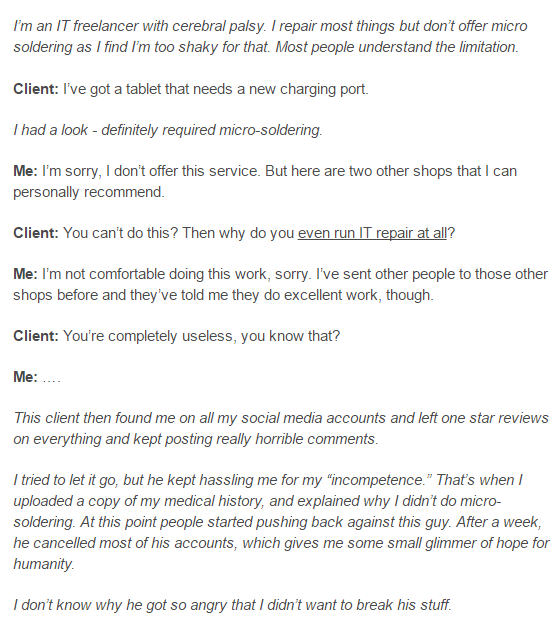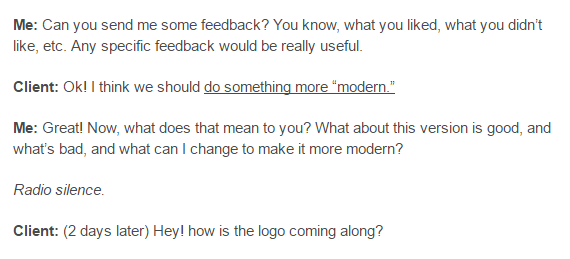What do “clients from hell” look like?
Do they have a pair of horns on the head and a tail sticking out in the back? Or maybe it’s the trident they carry around that gives them away?
Unfortunately, in most cases, we realize that the client is not an angel only when we’re already in hell with him/her.
Delayed payments, insults, your blind and unsuccessful efforts to live up to client’s high expectations – it all becomes your reality if you are unlucky enough to make a deal with the devil.
If only you knew from the very beginning that the client is going to be such a pain…
Fortunately, it is quite possible to identify unpromising deals. Read on to learn about 7 types of clients to stay away from and how to recognize them.
1. The cheap ones

They never pay on time and always have their reasons to do so: no money right now, no time to take care of the bill, sudden business trips or health problems.
If they do pay, they demand discounts, freebies, and other bonuses. After all, they chose you among many other freelancers, so why can’t you do some free work to make your customer happy?
At the same time, if you tell them that a “minor change” they asked for amounts to a whole new project with a different fee, they get super upset and tell everyone how mean and unreliable you are.
How to spot them:
- They ask “How much do you charge?” even before explaining what they want.
- They deliberately use vague wording when providing instructions. Then they complain you didn’t manage to meet their expectations and either don’t pay at all or make you do more work for free.
- Whenever you have new ideas concerning the project and want to discuss them, the conversation boils down to “do I have to pay extra for that?”
What to do:
The first thing that will help you deal with such clients is a contract.
It is, of course, great when your relationship with a client is based on trust and mutual respect. However, having a legal document defining expectations and responsibilities of each party is, undoubtedly, better.
The second thing you should think about is a paid deposit.
Collect it before you start working and make no exceptions to this rule. In case the customer cannot pay now, tell him you’re ready to start working whenever he/she is ready to make a payment.
Also, always ask your client for a really detailed brief to make sure there’s no misunderstanding between you two. In such a way you protect yourself from “it’s not quite what I wanted” situations.
2. The decide-for-me ones
They don’t know their budgets, priorities, and can’t give you detailed project instructions.
They expect you to come up with ideas by yourself and then are unhappy when what you offer does not match their idea of what they wanted. So you have to redo the work again and again. For free.
Even if you know how to read minds, chances are little that you’ll ever understand what exactly they are looking for. They don’t even seem to know it themselves.

How to spot them:
- “Just take care of it” is their favorite phrase.
- They seem indifferent, disengaged, and disinterested. You won’t hear them enthusiastically talking about their business or sharing thoughts concerning the project.
- They rarely ask for work samples or references.
- They agree to pay “whatever it takes” and never negotiate. However, when they see the final bill, they complain about it.
What to do:
Remember that coming up with ideas is not quite your job. You get paid to turn ideas into reality.
If you are not sure you understand what the customer wants, do not take this project.
In case the task seems like something you’d like to work on, be prepared to spend a lot of time on the phone trying to drag information out of your customer with red-hot pincers.
The decide-for-me ones often don’t understand that they should be more precise in their explanations. You’d have to be pushy but friendly at the same time.
Maintaining a humorous tone will help you solve many issues and turn those indifferents into lifelong customers.
3. The client-is-always-right ones
They find it acceptable to call you in the middle of the night (who cares about time zones?), on Christmas (screw the holidays, I need work done by 11 am tomorrow morning!) or when you’re on vacation (why didn’t you take your laptop with you?).
They often delay payments. Not because they don’t have money but to watch you beg for it.
They think they are doing you a favor by giving this job. So you’ll never hear “please” or “thank you” from them. After all, why should they be polite with “the help”?
How to spot them:
- They demand, not ask.
- They communicate in a rude and disrespectful manner.
- They provide extremely detailed briefs which are mostly about what you should NOT do when working with them rather than how they see their future project.
- They demand hourly reports and might even insist that you install a time-tracking software to monitor every your step.
What to do:
The best you can do in such situations is, of course, avoid such clients in the first place.
However, if the storm is inevitable, be honest about your expectations. You don’t work FOR your client; you work WITH him/her.
Set your own rules and demand that the client respects them. A contract can also be helpful in this situation.

4. The absent ones

These customers are nice, appreciative, and quite fun to work with.
Until one day you need them to approve your work or pay an invoice.
For some unknown reason, the minute they are forced to make an important decision, they disappear off the radars and all your requests vanish somewhere in the universe.
How to spot them:
- They rarely respond to your emails (if respond at all), and even when you hear back from them, you find no answers to your questions.
What to do:
You have no other way but be persistent.
Unless you know your client is on vacation or sick, be prepared to send dozens of emails, voicemails, and follow-ups.
Make your messages short and to the point. Set deadlines for replies. Reach out to your client’s co-workers or other people who might be able to get through to him/her.
Also, remember that even though those clients are hardly there, they still expect you to deliver the work on time.
Therefore, do not wait till your lucky day comes: mind your deadlines and learn how to be resourceful even without your client’s insight.
5. The explorers
Simply put, they ask you to do a part of the job for free (to get a grasp of what your work looks like), you do the heavy lifting, and then they hire a cheaper person.
How to spot:
- Their favorite phrase is “I want to try before I buy”.
- They refuse to sign a contract and avoid talking about money. Keyword – “We’ll worry about that later”.
- They seem genuinely interested in your previous projects but only to identify if you are good enough to be their next victim.
What to do:
There’s nothing wrong with giving your clients-to-be free samples of your work.
But if you are asked to take on a completely new task just to hear “thank you” in the end, beware.
Even if this a trial project, charge at least the minimum but non-refundable fee. Of course, you can subtract this sum from the final bill later on.
6. “I know how to do it, I just don’t have the time”
They are former writers (web developers/programmers) or at least have a college degree in English (computer science).
They know better what to do and enjoy teaching you how to do your own job. They never accept your rules and insist on everything being done their way.
Deep down they think you’re really incompetent. Yet for some reason still decide to hire.

How to spot them:
- They’ll tell you about their background as writers/designers/web developers the minute they walk in the door.
- Keyword – “I have [X] years of experience as [Y]. I know exactly what works and what doesn’t.”
- Micromanagement is their second name. They want detailed reports on everything you do and enjoy interfering in your work process.
What to do:
Well, the first thing you need to know about such people is that they never admit that they are wrong.
Therefore, be careful when choosing expressions and try not to sound too harsh.
Praise them for their ideas, listen attentively to what they say, be kind, polite, and don’t forget that humor is your secret weapon.
7. The perfectionists
Their mission is to build the best app the world has ever seen.
Because they want everything to be perfect, they are extremely picky, demanding, and therefore always dissatisfied.
As a result, you end up working more than expected for free just because the old idea was not perfect enough and they have come up with a new one.
How to spot them:
- They take their time to study the contract and consult their lawyer prior to hammering out an agreement.
- They carefully scrutinize your work samples and might even contact your previous clients to ask for their feedback.
- They micromanage. A lot.
- Their briefs are among the most detailed you’ll ever get.
What to do:
When in Rome, do as the Romans do. Be perfect.
Simply give this client exactly what he/she wants. Make sure the dark gray the client requested is dark enough and always stick to the deadlines.
Also, it is wise to develop a revision policy and introduce it to your clients.
Is there a limit for free revisions? At what point are the edits considered final? In case it’s the fifth time you start the project from scratch, what is the fee?
Takeaway:
These are 7 types of clients that drive freelancers nuts the most often.
However, we are forced to deal with many other troublesome clients along the way.
What is your experience? What clients would you recommend to stay away from? And, most importantly, how to deal with them? Feel free to share your thoughts in the comments!
Screenshot credit: https://clientsfromhell.net/
About the Author:



